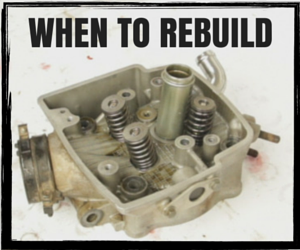When to Rebuild Your Engine

This week I’d like to start a long series of posts on the proper way to rebuild a four-stroke engine. I will share with you a top to bottom rebuild where I go through the disassembly, inspection of parts, and reassembly of the engine. We’ll cover the top end, bottom end, and everything in-between. I’ll pass on the tips and tricks I’ve learned over the years from the people I’ve worked with in the motorcycle industry. Hopefully these tips will benefit you on your next engine build, save you money, and ensure you do things properly.
Before I get into the specifics I want to discuss the importance of preparing for the rebuild. This week let’s talk when to tear into the engine.
When to replace: Engine wear is directly related to RPM and mechanical stress so riders engaging in riding where the engine is on the rev limiter frequently, the engine is operating at a high RPM without any load on it, the gearbox is loaded or unloaded abruptly, or gears are selected hastily will require the rider or mechanic to service the engine frequently. Most of you will relate the scenario I have illustrated to motocross racing. At the top levels of racing, mechanics are constantly checking or rebuilding the engines to make sure they are operating at maximum power.
Fortunately for most of us we are not riding or racing at the top level, so our bikes and engines last quite awhile longer. Unfortunately everyone’s scenario is different- depending on the type of riding you do, the environment you ride in, how often the oil is changed, etc. which makes it difficult to standardize or pinpoint any sort of service interval.
As an engineer, mechanic, and rider my philosophy has always been to replace components preventatively before they fail. My reasoning here is that the costs attributed with a failed component are much higher than a replaced component. Let us consider a scenario where a piston fails. This could have been avoided had I replaced the piston and would have cost around $130. Instead it’s quite likely that the entire engine will need to be opened up and serviced, making the price of the repair extremely expensive.
From an opportunity point of view, if any part fails on the bike while I’m out riding or racing I’ve lost out on a significant amount of time, a significant amount of points if I’m racing, and a wad of cash when it comes to paying to get to and from the venue. So apart from saving a small amount of money by not replacing a serviceable part, there is no upside to trying to prolong the life of a component. The ramifications of engine neglect are nothing to scoff at.
The best way to determine when components need to be serviced is to keep careful track of the health of your engine. This means from the time of purchase to the day you sell you keep track of all the engine hours, maintenance, and repairs you do to the bike. By keeping track of engine time you’ll start to develop patterns and be able to establish your own service intervals. I wrote a nice article about maintenance logging which you can read HERE.
Along with keeping a log from day one, I also like to do a compression test any time I get a new bike so I can establish a baseline for the health of the engine. As I put hours on the bike, if I ever become suspicious that the engine is down on power I can perform another compression test. Then I can quickly refer back to my first test to determine if I have lost any compression and might need to consider servicing the top end.
The next thing you must do is pay attention to your engine. In most cases your engine will give you signs that it is time to service one component or another. Some common signs that may indicate your engine is due for servicing soon are:
-
Hard to Start - This could be due to a fueling issue, ignition issue, decompression system out of adjustment, worn rings, worn valves and seats, a stuck valve, leaking gaskets, or cam timing that is off.
-
Engine Power has Diminished - This could be due to restricted fuel flow in the carburetor or throttle body, a clogged air cleaner, the clutch slipping, worn valves and seats, worn rings, a stuck valve, leaking gaskets, or ignition issues.
-
The Top End is Noisy - A noisy top end could be caused by a loose cam chain, out of spec valve clearances, a worn cam chain guide, or worn cam bearings.
-
The Bottom End is Noisy - A worn clutch basket which has started to rattle, damaged or stuck bearings, a worn bushing and needle bearing between the clutch basket and primary shaft, or gears which are improperly lubricated may all contribute to bottom end noise.
-
Blue Smoke - Blue smoke occurs when the engine is burning oil. Either the valve seals are allowing oil to leak past them or the piston rings are no longer sealing properly. Once the engine is warm very little blue smoke should ever be seen.
-
White Smoke - White smoke is emitted when the engine is burning coolant. This typically occurs when a head gasket starts leaking.
-
The Engine Consumes Oil - Oil is getting into the combustion chamber any time the engine consumes oil. Oil can either enter into the combustion chamber from worn valve seals or worn piston rings.
-
The Engine Oil is Creamy - Whenever the engine oil is creamy in color moisture is getting into the engine oil. While some moisture getting into the oil is normal excessive amounts are a cause for alarm and may indicate that a water pump seal is leaking.
-
The Engine Oil has Large Pieces of Metal in It - Metallic particles are common in engine oil but if larger metal pieces are found in the oil this is a cause for concern and should be associated with damaged components. An example of this could be finding fragments of chipped gear teeth in oil.
-
The Engine Vibrates Excessively - Excessive engine vibration may be caused by an out of true crankshaft, worn crank bearings, worn counterbalance bearings, a mistimed counterbalancer, or a loose clutch.
One last tool I want to mention that is helpful in determining the health of an engine is a leak down tester. With the piston at TDC and the valves closed (compression stroke) a leak down test pressurizes the cylinder to a specified pressure. A comparison is made between how much air is supplied to the cylinder and how much leaks out. The amount of air leaking out of the cylinder is used to determine the health of the engine. For example if 70% of the air is leaking out the cylinder there are serious problems! By carefully listening for the air leak(s) it is possible to determine the cause of the problem.
I would really like to help you guys out and give you quantifiable numbers so that you know precisely when the right time is to rebuild your engine however I feel that by doing this I would be doing a disservice to a lot of you. I would either be giving you information that tells you to rebuild your engine too early or too late in its life which wouldn’t be good for anyone. As I mentioned before there are so many variables ranging from riding style, engine displacement, manufacturer, riding environment, and maintenance intervals that I can’t quantify all these things into one number for everyone or even several numbers for specific groups. Your best bet is to pay close attention to your engine, keep track of the hours on your engine, and learn as much as you can about your particular make and model so that you can begin to formulate a service interval schedule tailored to you.
Questions, comments, or additional tips leave a comment below!
Moto Mind - Empowering and Educating Riders From Garage to Trail
If you'd like to follow my blog, click the "follow this blog" button in the upper right. I'd love to have you. ?
-
 16
16



16 Comments
Recommended Comments